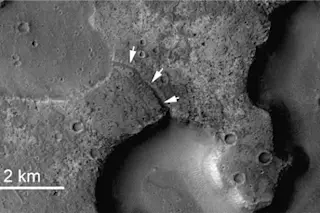NASA's Mars Reconnaissance Orbiter (MRO) has taken detailed pictures of what scientists are saying is evidence that large lakes of liquid water sat on the planet's surface relatively recently--which is to say, about 3 billion years ago. MRO imaged several deep depressions that scientists previously attributed to the sublimation of underground ice 4 billion years ago. However, the new images show that the depressions are connected by long channels, and researchers say
these channels could only be formed by running water, and not by ice turning directly into gas. The scientists' ageing of the region, which on bodies like Mars is done by counting craters, suggests the features formed during the so-called Hesperian Epoch on the Red Planet [BBC News]
. Essentially, this means that there was water on Mars a billion years more recently than previously thought. The findings were published in the journal Geology. The researchers aren't quite ...














